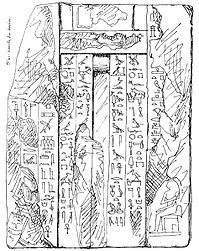- Meresankh IV
-
-
- For other royal ladies named Meresankh, see "Meresankh".
Meresankh IV 
Stela showing Meresankh IV,
from her tomb in Saqqara[1]Born Meresankh Resting place tomb 82 in Saqqara Residence Egypt Other names Meres-ankh Occupation Queen of Egypt Religion Ancient Egyptian religion Spouse possibly Menkauhor Kaiu, possibly Djedkare Isesi Children Prince Remkuy and Prince Kaemtjenent Parents unknown Meresankh IV was a Queen of Egypt in the 5th dynasty. Her name means "she loves life".
Biography
Meresankh IV was a queen of Ancient Egypt towards the end of the 5th dynasty. While some sources consider that her husband is unknown,[2] other sources suggest her husband was the pharaoh Menkauhor Kaiu.[3][4] It is also possible that Meresankh IV was the wife of the pharaoh Djedkare Isesi.[5]
Meresankh IV may have had sons: Remkuy (Raemka) and Kaemtjenent. The family relationship between Meresankh and Remkuy and Kaemtjenent are based on the general dating of their monuments (mastabas in Saqqara). It is possible that Kaemtjenent may have been a son of Djedkare Isesi rather than Menkauhor Kaiu.[3]
Titles



Meresankh IV
in hieroglyphsThe titles of Meresankh IV were: Great one of the hetes-sceptre, King’s Wife, Great of Praises, She who sees Horus and Seth, Priestess of Thoth, Priestess of Tjazepef, Directress of the butchers in the acacia house, Attendant of Horus, Companion of Horus, Consort and beloved of the Two Ladies, Companion of Horus[2].
She was buried in tomb 82 in Saqqara[2][3] - tomb D5 in Marriete's Mastaba. The tomb only had one chamber and there were no inscriptions on the walls. The text recording queen Meresankh IV comes from a stela found in the tomb along with a serdab.[1]
Sources
- ^ a b Mariette, Auguste. Les Mastabas de l'Ancien Empire. Publiés d'après le manuscrit de l'auteur par Gaston Maspero. Paris: F. Vieweg, 1889.
- ^ a b c Grajetzki, Ancient Egyptian Queens: A Hieroglyphic Dictionary, Golden House Publications, London, 2005, ISBN 978-0954721893
- ^ a b c Dodson, Aidan and Hilton, Dyan. The Complete Royal Families of Ancient Egypt. Thames & Hudson. 2004. ISBN 0-500-05128-3
- ^ J. Tyldesley, Chronicle of the Queens of Egypt, Thames and Hudson, 2006
- ^ Cambridge Ancient History Volume 1 Part 2, 2008
Categories:- 25th-century BC women
- 24th-century BC women
- Ancient Egyptian queens consort
- Fifth dynasty of Egypt
-
Wikimedia Foundation. 2010.
